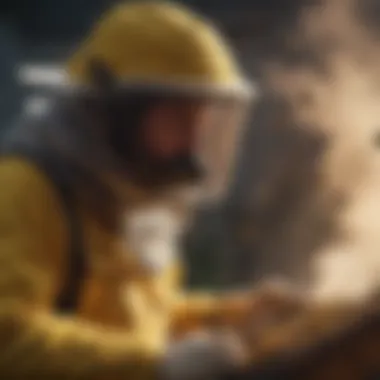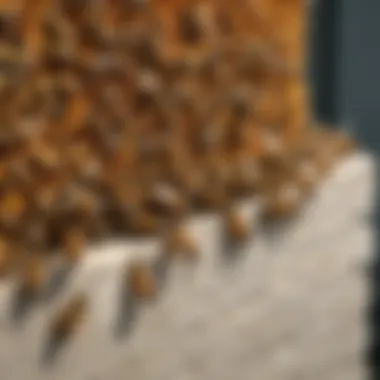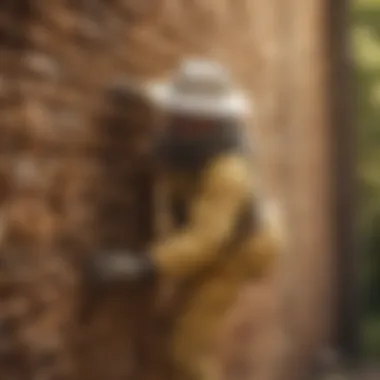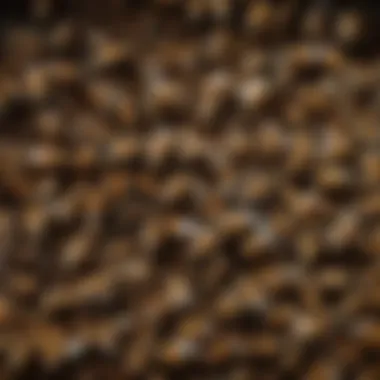Effective Methods for Removing Bees from a Block Wall


Preventive Pest Control Strategies
When it comes to effectively managing pests around our homes, having a proactive preventive approach can save us time, money, and potential headaches. Starting with House Exterior Protection, sealing cracks in the exterior walls is crucial in preventing pests, like bees, from finding their way into our homes. It's essential to also clear debris regularly to eliminate potential harborage spots for insects. Furthermore, implementing strategies to prevent pests from entering the house through various entry points is key to maintaining a pest-free environment.
In terms of Yard Maintenance, adopting essential yard care routines such as regular mowing, trimming shrubs, and removing standing water can significantly reduce pest activity in outdoor areas. Implement methods like proper waste management and removing clutter to keep the yard pest-free. Indoor Cleanliness is equally vital, as expert cleaning tips and techniques should be employed to eliminate crumbs, spills, and other attractants that might entice pests indoors. Maintaining a clutter-free, organized indoor environment is vital in keeping pests at bay.
Efficient Garbage Disposal practices are essential in preventing pests from being drawn to our homes. Proper waste disposal methods, such as using tightly sealed bins and disposing of garbage regularly, can deter pests from foraging in trash. It's also important to educate oneself on the impacts of Other Pest Prevention Strategies to safeguard our homes effectively against a wide range of pest invaders.
Understanding the Situation
When it comes to the process of removing bees from a block wall, it is crucial to first understand the situation at hand. This initial step sets the foundation for a successful and safe bee removal process. By gaining a deep understanding of the factors involved, one can effectively plan and execute the removal with precision. Understanding the situation encompasses various aspects that are instrumental in ensuring a smooth removal operation.
Identifying the Bee Species
One key element in understanding the situation is identifying the specific bee species that have made a home within the block wall. Different bee species have varying behaviors and characteristics, which can influence the approach taken during removal. By determining the exact species present, bee removal experts can tailor their methods to suit the particular bees, ensuring a more efficient and humane removal process. This information also aids in taking necessary safety precautions based on the behavior of the identified bee species.
Assessing the Hive Location


Another vital aspect of understanding the situation is assessing the precise location of the bee hive within the block wall. The hive's location influences the way it is approached during removal, taking into account factors such as accessibility and potential risks. By accurately determining the hive's position, removal experts can strategize the best course of action to safely extract the bees. This assessment helps in planning the removal process effectively, considering factors such as structural integrity and environmental impact.
Understanding Bee Behavior
Lastly, understanding the behavior of bees plays a significant role in the removal process. Bee behavior can vary depending on factors such as environmental conditions and hive size. By comprehending how bees typically respond to disturbances and changes in their surroundings, removal experts can predict their reactions during the removal operation. This knowledge enables them to employ techniques that minimize the likelihood of aggressive behavior from the bees, ensuring a safer removal process for both the bees and the removal team. Understanding bee behavior is essential for executing a successful removal operation with minimal disruptions and risks.
Preparation and Safety Measures
In the realm of bee removal from block walls, Preparation and Safety Measures play a crucial role in ensuring a smooth and safe process. Before embarking on the removal journey, it is essential to meticulously plan and prepare for every step to prevent any unwanted incidents. Firstly, gathering the necessary equipment is paramount. Tools such as bee suits, protective gloves, smoke guns, and hive removal tools are indispensable for a successful extraction. These items not only safeguard the removal process but also protect the individuals involved from potential bee stings and associated risks.
Securing the work area is another vital aspect to consider. Creating a secure perimeter around the block wall hive ensures that the bees are contained within a controlled space, minimizing the chances of accidental disturbances. By setting up barriers and signs to alert others of the operation in progress, safety protocols are reinforced, reducing the likelihood of unexpected interference.
Moreover, having the appropriate protective gear is non-negotiable when dealing with bees. Bee stings can cause severe allergic reactions in some individuals, underscoring the importance of donning protective clothing. From beekeeping suits to sturdy boots and mesh veils, each gear item serves as a protective layer against bee attacks, providing a safe environment for the removal process. Prioritizing safety measures not only safeguards the individuals involved but also ensures a humane approach towards bee removal and relocation.
Safe Removal Techniques
In this section, we delve into the critical aspect of safe removal techniques when dealing with bees nestled within a block wall. Ensuring the safety of both the environment and the bees themselves is paramount throughout this process. Implementing the correct methods not only protects these essential pollinators but also prevents any potential harm or disruption. Effective safe removal techniques contribute significantly to successful bee relocation without adverse consequences.


Using Smoke to Calm Bees
When it comes to bee removal, employing smoke to calm bees is a longstanding practice that fosters a smoother extraction process. The use of smoke disrupts their communication and alert system, inducing a sense of tranquility among the bees. This technique is vital in lowering the chances of bee aggression during removal, making it safer for both the remover and the bees themselves. It is crucial to understand the correct amount of smoke needed and the proper way to administer it for maximum effectiveness.
Careful Extraction Methods
Careful extraction methods are fundamental in ensuring that bees are safely and gently removed from their block wall habitat. Gentle handling minimizes stress on the bees and reduces the risk of injury to both the bees and the individuals conducting the removal. The precise and methodical approach to extracting the bees plays a significant role in the success of relocating them to a new location unharmed. Careful attention to detail and a steady hand are key elements in executing extraction methods efficiently.
Transporting Bees to a New Location
Transporting bees to a new location after removal is a crucial step in the process of relocating them without causing harm. Safe transportation methods involve securing the bees in appropriate containers that ensure their well-being during transit. Factors like temperature regulation, ventilation, and minimizing disturbances are essential considerations when relocating bees. Ensuring a smooth and comfortable journey for the bees contributes to their successful integration into their new environment.
Post-Removal Steps
After successfully relocating bees from a block wall, it is crucial to undertake post-removal steps to ensure a safe environment for both humans and bees. These steps play a vital role in preventing future infestations and maintaining the wellbeing of the surrounding ecosystem. Let's delve into the specific elements, benefits, and considerations associated with post-removal tasks.
Sealing Entry Points


To prevent bees or other pests from reoccupying the vacated hive in the block wall, it is imperative to seal all entry points. Inspect the wall meticulously to identify any crevices or openings that could serve as potential entryways. Utilize appropriate sealants or materials to close off these gaps effectively. By sealing entry points, you not only deter bees from returning but also enhance the structural integrity of the wall.
Cleaning and Disinfecting the Area
Once the bees have been relocated, the area where the hive existed must undergo thorough cleaning and disinfection. Remove any remnants of the hive, including honeycombs, wax, and bee debris. Use suitable cleaning agents to sanitize the area and eliminate any pheromones that might attract bees back to the site. By cleaning and disinfecting the area, you mitigate the risk of future bee infestations and promote a hygienic environment.
Monitoring for Bee Activity
Ongoing monitoring for bee activity is essential post-removal. Keep a close eye on the previously infested area for any signs of bee presence or swarm activity. Regular inspections will help in early detection of potential re-infestations and allow for prompt intervention if needed. Monitoring for bee activity ensures that any resurgence of bees can be addressed swiftly, safeguarding the area from future infestations.
Seeking Professional Help
Seeking professional help when dealing with bee infestations in block walls is crucial for a successful and safe removal process. Professional bee removal experts have the knowledge, experience, and tools necessary to handle bee colonies efficiently without causing harm to the bees or the environment. By entrusting the task to professionals, homeowners can ensure that the bees are relocated properly and the block wall is cleared of any potential dangers.
When to Consult Bee Removal Experts
Consulting bee removal experts is advisable in situations where the bee infestation in the block wall is extensive or poses a threat to the safety of residents. Professional bee removal services can assess the severity of the infestation, determine the best course of action, and safely remove the bees without causing harm. They have the expertise to identify bee species, locate hives, and implement effective removal strategies tailored to each situation.
Choosing Reputable Bee Removal Services
Selecting reputable bee removal services is essential to ensure that the bees are handled ethically and according to established guidelines. When choosing a bee removal service, homeowners should verify the company's credentials, experience, and reputation in the field. It is also important to inquire about their removal methods, relocation practices, and commitment to environmental sustainability.
Understanding Legal Regulations
Understanding legal regulations related to bee removal is critical to avoid any potential legal issues or liabilities. Different regions may have specific laws concerning the treatment and relocation of bees. Professional bee removal services are well-versed in these regulations and can ensure that the removal process complies with all legal requirements. By adhering to established guidelines, homeowners can prevent legal repercussions and ensure a lawful and responsible bee removal process.



